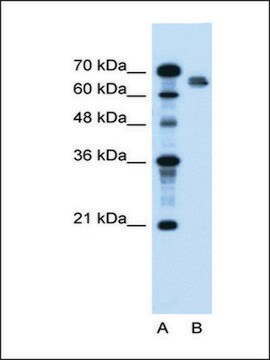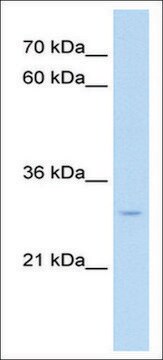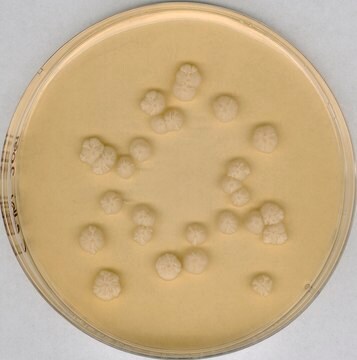ABE2867M
Anti-NR5A2 (LRH1)
from rabbit
Sinónimos:
Nuclear receptor subfamily 5 group A member 2, Alpha-1-fetoprotein transcription factor, B1-binding factor, hB1F, CYP7A promoter-binding factor, Hepatocytic transcription factor, Liver receptor homolog 1, LRH-1
About This Item
Productos recomendados
origen biológico
rabbit
Nivel de calidad
forma del anticuerpo
unpurified
tipo de anticuerpo
primary antibodies
clon
polyclonal
reactividad de especies
human, mouse
envase
antibody small pack of 25 μL
técnicas
ChIP: suitable (ChIP-seq)
immunofluorescence: suitable
immunoprecipitation (IP): suitable
western blot: suitable
isotipo
IgG
Nº de acceso NCBI
Nº de acceso UniProt
modificación del objetivo postraduccional
unmodified
Información sobre el gen
human ... NR5A2(2494)
Descripción general
Especificidad
Inmunógeno
Aplicación
Western Blotting Analysis: A representative lot detected NR5A2 (LRH1) in Western Blotting applications (Chalkiadaki, A., et. al. (2005). Mol Cell Biol. 25(12):5095-105; Stergiopoulos, A., et. al. (2016). Nat Commun. 7:12230).
Immunofluorescence Analysis: A representative lot detected NR5A2 (LRH1) in Immunofluorescence YES titration paraffin sections from E10.5 (a), E12.5 (b), E14.5 (c) or E16.5 (d) mouse spinal cord (Stergiopoulos, A., et. al. (2016). Nat Commun. 7:12230).
Epigenetics & Nuclear Function
Calidad
Western Blotting Analysis: A 1:1,000 dilution of this antibody detected NR5A2 (LRH1) in 10 µg of HEK293 cell lysate.
Descripción de destino
Forma física
Almacenamiento y estabilidad
Handling Recommendations: Upon receipt and prior to removing the cap, centrifuge the vial and gently mix the solution. Aliquot into microcentrifuge tubes and store at -20°C. Avoid repeated freeze/thaw cycles, which may damage IgG and affect product performance.
Otras notas
Cláusula de descargo de responsabilidad
¿No encuentra el producto adecuado?
Pruebe nuestro Herramienta de selección de productos.
Código de clase de almacenamiento
12 - Non Combustible Liquids
Clase de riesgo para el agua (WGK)
WGK 1
Punto de inflamabilidad (°F)
Not applicable
Punto de inflamabilidad (°C)
Not applicable
Certificados de análisis (COA)
Busque Certificados de análisis (COA) introduciendo el número de lote del producto. Los números de lote se encuentran en la etiqueta del producto después de las palabras «Lot» o «Batch»
¿Ya tiene este producto?
Encuentre la documentación para los productos que ha comprado recientemente en la Biblioteca de documentos.
Nuestro equipo de científicos tiene experiencia en todas las áreas de investigación: Ciencias de la vida, Ciencia de los materiales, Síntesis química, Cromatografía, Analítica y muchas otras.
Póngase en contacto con el Servicio técnico








